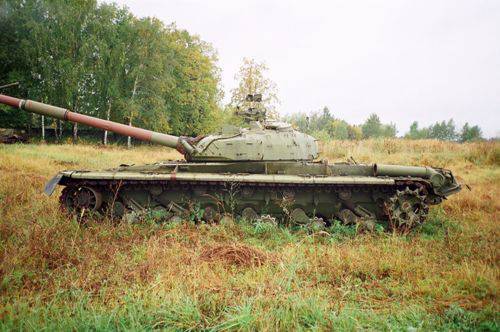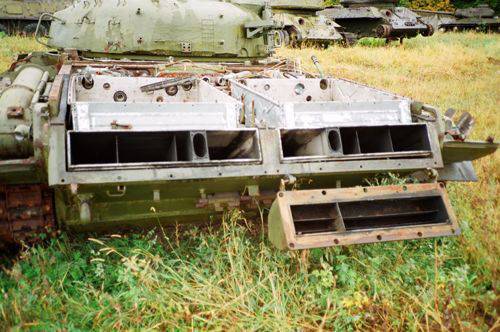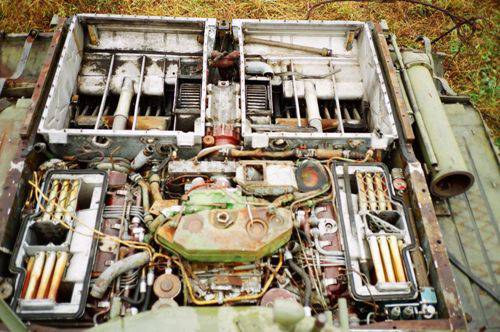Tank "Object 219РД" and engine 2В-16-2
The abandoned and rusting car was a prototype of the Object 219RD project, which appeared at the very end of the seventies. Adopted shortly before, the T-80 had good performance, which was provided by a gas turbine engine with a capacity of 1000 horsepower. However, the payment for the relatively high speed and ease of operation in winter conditions turned out to be too high fuel consumption. The power reserve of the T-80 was significantly less than that of other Soviet main tanks that time. In addition, a gas turbine power plant cost an order of magnitude more than a diesel engine of similar power. Therefore, already in the late seventies, the Ministry of Defense initiated the development of a tank modernization project, the purpose of which was to preserve the driving performance of the armored vehicle, while increasing fuel efficiency and reducing the cost of the finished tank.
At this time, the designers of the Chelyabinsk Tractor Plant were working on the creation of a family of 2V tank diesel engines. It was planned to make several four-stroke X-engines with power from 300 to 1600 horsepower. It was the engine of the 2V family that was chosen as the power plant for a new modification of the T-80 tank, called the Object 219RD. With the development of new engines, a remarkable story. Initially, in 1976-77, a 16-cylinder diesel engine with a capacity of 1000 hp was designed at ChTZ. However, by the time the design work was completed, it turned out that the defense industry did not need such a motor. All the tanks on which he could work were already equipped with other types of engines. Therefore, on the basis of the resulting 2V-16-1, they began to create a more powerful 2V-16-2 with a maximum power of up to 1200 hp.
Using the 2V-16-2 engine, Chelyabinsk engineers created the MTU-2 engine-transmission unit, which was an engine and transmission assembled into a single unit. This approach to design was used for the first time in Soviet practice. Other features of the installation include a hydrodynamic transmission, an electro-hydraulic control system, original cooling units, and air filters. The monoblock propulsion system occupied a volume of only 3,6 cubic meters.
In the early eighties, one of the serial T-80B tanks was reworked to the state of "Object 219RD". The original power plant with a gas turbine engine was removed from it, the place of which was taken by the MTU-2 unit. The motor-transmission monoblock showed itself well already at the installation stage. In the course of checking the maintainability of the tank with it, a team of four repairmen was able to replace the engine and transmission in just 65-70 minutes. It is worth noting that not only Leningrad designers from the Kirov Plant, who created the Object 80RD, took up the modernization of the T-219B. At the same time, the Chelyabinsk Tractor Plant was designing the Object 785 tank with a similar power plant. A characteristic feature of the new Chelyabinsk experimental tank was a longer hull with seven road wheels on board. Only one instance of such an armored vehicle was built, mass production did not begin.
"Object 219RD", which received new power plant units, turned out to be slightly heavier than the original T-80B and weighed almost 44 tons. Due to the fact that the power of 1200 hp. was the maximum for the 2V-16-2 engine, the running characteristics of the new tank turned out to be slightly lower than that of the base model. The maximum speed of the "Object 219RD" decreased to 60-65 kilometers per hour, which, however, was offset by a large power reserve. Due to the less voracious diesel engine, he could cover about 500 km at one gas station.
Converted from a serial armored vehicle "Object 219RD" in all respects corresponded to the T-80B, not counting the units of the engine compartment. The tank retained combined armor based on rolled sheets. Due to a slight increase in engine power, the undercarriage also did not change: the previous six road wheels with torsion bar suspension on each side remained. The armament complex of the "Object 219RD" consisted of a 2A46-2 gun-launcher with the ability to launch anti-tank missiles of the 9K112-1 "Cobra" complex, two machine guns (anti-aircraft NSVT caliber 12,7 mm and coaxial with a 7,62-mm PKT gun) and smoke grenade launchers. The use of weapons was provided by the 1A33 fire control system, coupled with a weapons stabilizer, ballistic computer, laser rangefinder, etc. In general, the armament and electronics of the experimental tank corresponded to the set of equipment installed on the T-80B of the early series.



In the mid-eighties, several samples of the 2В-16-2 engines underwent interdepartmental tests, during which each of them worked over 700 hours. At the same time, the ground tests passed the prototype of the “219RD Object”. During the trips to the tankdrome, the armored car almost completely consumed the resource of the engine installed on it. Feedback from testers and customers was generally positive. The lower maximum speed was more than offset by a large power reserve and a significantly lower cost of the diesel engine. However, the fate of the project decided not technical and non-economic features.
First of all, the views of the military had a bad effect on the Object 219RD project. This tank was considered only as a replacement for the T-80B in case it was necessary to quickly deploy mass production. In addition, the relevant departments were in no hurry to prepare the industry for the production of the new 2V-16-2 engine, and the Chelyabinsk Tractor Plant itself could not master its mass assembly due to the workload of its capacities. The end of the history of this motor, and with it the Object 219RD project, was several documents published by the leadership of the defense industry. In 1988, the 2V-16-2 diesel engine and the MTU-2 unit were recommended for serial production, after which all the documentation went into the archive.
Shortly thereafter, the customer, represented by the Ministry of Defense, made an attempt to preserve the 2V engine family and, possibly, the Object 219RD tank. The Chelyabinsk Tractor Plant was ordered to develop a unified power plant for all tanks in service. The 12-cylinder X-shaped engine 2V-12-2 was taken as the basis for it, the power of which was brought to the level of the previous 2V-16-2. However, in the future, the military abandoned such engines. The renewal of the fleet of armored vehicles was considered unprofitable, as a result of which all the documents on this project also went to the archival shelf. The 2B engine family still exists, but even 25 years after those events, it has not received proper distribution.
The tank "Object 219RD" itself was sent for storage as unnecessary. A couple of years ago, photographs appeared in the public domain, which captured the state of an experimental armored vehicle that no one needed. The abandoned tank made a sad impression: some parts were missing, while others were covered with rust. Thus ended one of the attempts to equip the T-80 tank with a diesel engine. It is worth noting that this idea later nevertheless bore fruit in the form of the main battle tank T-80UD "Birch". However, this development was not destined to serve for a long time. By the end of the nineties, all the "Birches" of the Russian armed forces were decommissioned due to technical problems.
On the materials of the sites:
http://otvaga2004.ru/
http://alexfiles99.narod.ru/
http://engine.aviaport.ru/
http://nvo.ng.ru/
http://vestnik-rm.ru/
http://military.tomsk.ru/blog/topic-308.html
Information